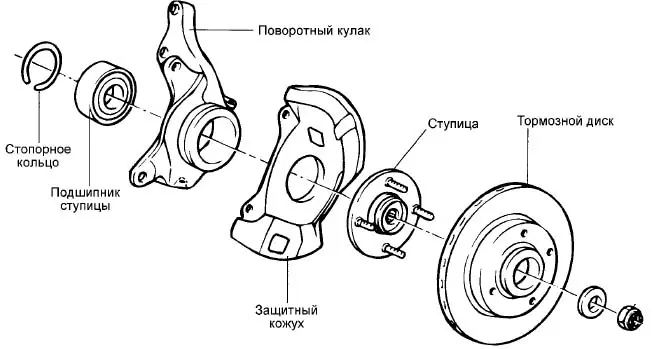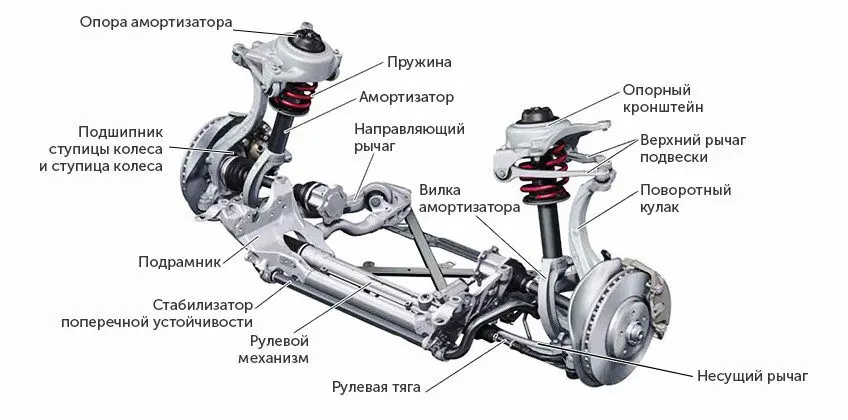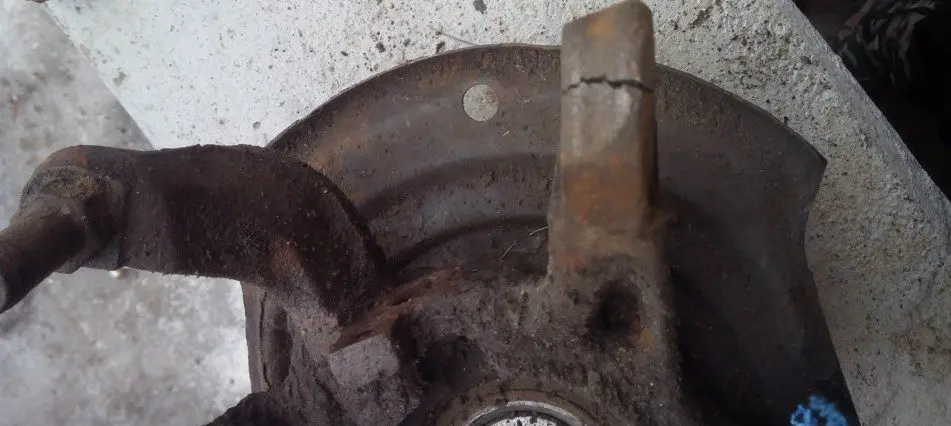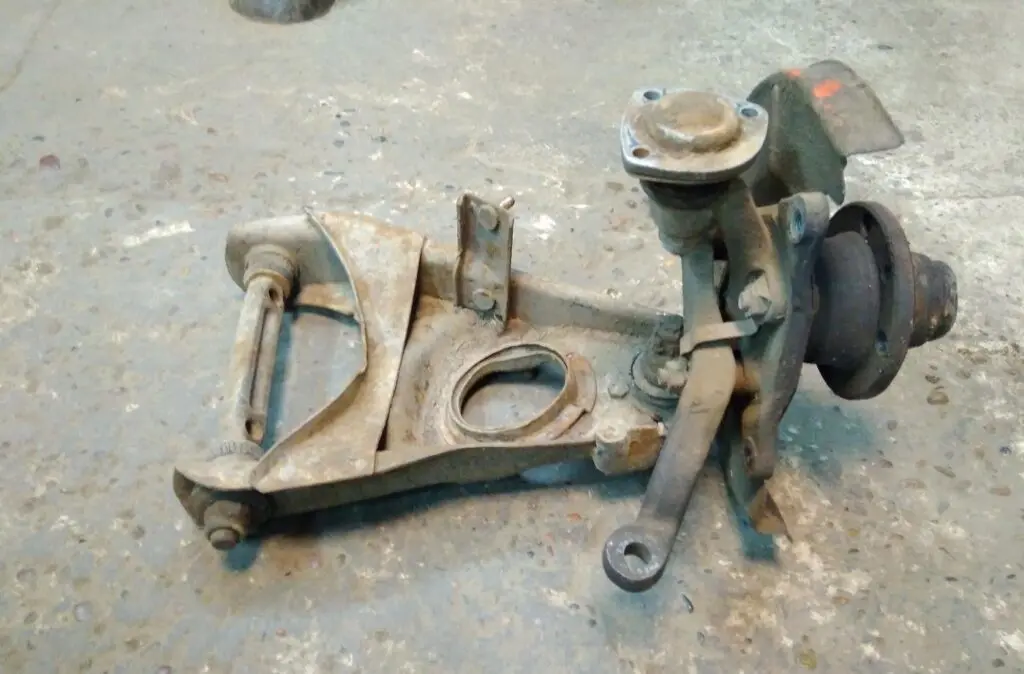
Поворотный кулак – устройство, неисправности, замена
Содержание
В устройство любого современного автомобиля входит такая часть, как поворотный кулак. Некоторым сложно отнести его к какой-то конкретной системе автомобиля, так как деталь выполняет некоторые функции нескольких механизмов.
Рассмотрим подробней, в чем особенность элемента, поговорим о разновидностях детали, а также принципе ее замены, когда возникает такая необходимость.
Что такое поворотный кулак
Можно смело сказать, что кулак – многофункциональная деталь. Она устанавливается на стыке нескольких систем, почему и возникает трудность с классификацией: к какой конкретно системе относится данный элемент.

На нем крепится часть рулевого управления, ступица колеса, стойка амортизатора и другое оборудование (например, элементы тормозов). По этой причине кулак – узел, на котором соединяются и синхронизируются данные системы. Так как на эту деталь оказываются серьезные нагрузки, то изготавливается она из прочного материала.
Некоторые производители используются для изготовления своей продукции высоколегированную сталь, а другие – чугун. Еще одна особенность поворотного кулака – предельно точная геометрическая форма. В зависимости от типа подвески и рулевого управления форма кулака может быть очень разной.
Для чего нужен поворотный кулак
Из самого названия вытекает одна из целей установки данной детали в автомобиле – обеспечивать поворот передних колес. Если машина заднеприводная, то кулак будет иметь более простое устройство.

Гораздо сложнее обеспечить поворот ведущему колесу, так как помимо изменения траектории на его ступицу нужно подать крутящий момент от трансмиссии. Наличие поворотного кулака решило сразу несколько задач:
- Обеспечило стабильную фиксацию вращающейся ступицы, на которой закреплено ведущее колесо;
- Дало возможность соединить вращающееся колесо не только с трансмиссией, но и с подвеской. Например, в модификации МакФерсон (ее устройство обсуждалось немного ранее) амортизационная стойка многих автомобилей крепится именно на этой детали;
- Позволяет узлу поворачивать без потери мощности при вращении колеса и сокращениях подвески во время езды.
Благодаря таким функциям кулак считается одновременно и опорой в ходовой части, и исполнительным элементом рулевого управления авто. В дополнение к перечисленным функциям на кулаке закрепляются некоторые части системы торможения.

Если деталь будет изготовлена с погрешностями в геометрии, некоторые системы могут быстро выйти из строя.
Рассматриваемая запчасть применяется на передней оси. Иногда идентично называется опора задней ступицы колес. Они имеют схожую конструкцию, только во втором случае деталь не предоставляет возможность поворачивать, поэтому ее нельзя назвать поворотной.
Принцип действия
Чтобы с помощью кулака срабатывала подвеска, в кулаке сделаны отверстия для крепления рычага (в нижней части) и амортизатора (верхняя часть). Стойка крепится обычным болтовым соединением, а вот рычаг – через шаровую опору. Этот элемент позволяет колесам поворачиваться.
Система рулевого управления (а именно рулевая тяга) также будет крепиться при помощи шаровых деталей (называются наконечниками рулевых тяг).

Для обеспечения вращения рулевых колес в поворотный кулак вставляется подшипник (автомобиль заднеприводный) или ШРУС (машина имеет передний привод).
В зависимости от условий на дороге поворотный кулак может одновременно, и обеспечивать поворот колеса, и его амортизацию, и подачу крутящего момента на ведущие ступицы.
О том, как взаимодействуют все системы в узле, смотрите в следующем видео, основанном на обзоре подвески машины:
Устройство и разновидности
Производители в своих автомобилях используют разные системы подвесок, поэтому и форма поворотных кулаков тоже разнится. Это является самой первой причиной, по которой следует подбирать деталь в соответствии с маркой автомобиля. В поиске поможет VIN-код, который указывает на особенности конкретного авто (о том, как расшифровать все символы, читайте отдельную статью).
Даже малейшее несоответствие может либо затруднить работу по установке детали, либо работоспособности механизмов. Например, из-за неправильного крепления рулевая тяга не сможет до конца повернуть колесо, потому что шаровая стала под неправильным углом и т.д.

Именно на поворотном кулаке крепится дополнительное оборудование, например, тормозные суппорты, а также датчики.
Было бы ошибкой думать, что производитель во всех автомобилях модельного ряда использует одинаковую конструкцию этих запчастей. Например, когда производитель инициирует процедуру рестайлинга (о том, что это такое, и зачем автопроизводители это делают, читайте здесь), инженеры могут изменить устройство детали так, чтобы на ней можно было закрепить датчик, которого не было в дорестайлинговой версии.
Неисправности и возможные симптомы
Существует несколько симптомов, по которым водитель может определить, что с поворотным кулаком возникли проблемы. Вот некоторые признаки:
- При движении по прямой автомобиль уводит в сторону. В этом случае в первую очередь проверяется развал-схождение (как делается процедура, читайте в другом обзоре). Если проблема не устранена, неисправность может заключаться в кулаке;
- Угол поворота колес заметно уменьшился. При этом стоит в первую очередь проверить шаровую опору;
- Оторвалось колесо. Чаще всего это происходит из-за выхода из строя шаровой (оборвало палец), но нередко такое случается, когда ломается проушина для монтажа крепления;
- Трещина корпуса или износ места установки подшипника. Это иногда случается при неграмотной установке элементов ходовой части (криво запрессован подшипник или не до конца закручены болты на колесе).

Что касается образования трещин, то некоторые автослесари предлагают восстановить деталь – заварить ее. Если запчасть стальная, то она подлежит восстановлению. Большинство же кулаков изготавливаются из чугуна.
Даже если сварщику удастся скрыть трещину, сам материал на месте обработки теряет свои свойства. Деталь, подвергающаяся сварочным работам, достаточно быстро сломается на первой же серьезной ямке.
В целях безопасности при обнаружении каких-либо дефектов деталь лучше заменить на новую. О том, как это делается, смотрите на примере конкретного автомобиля:
Как снять поворотный кулак?
Чтобы можно было снимать поворотный кулак, придется отсоединять все элементы, которые на нем закреплены. Процедура производится в следующей последовательности:
- Машина ставится на домкрат или вывешивается на подъемнике;
- Откручиваем соответствующее колесо;
- Демонтируем тормозной суппорт;
- Откручиваем крепление стойки амортизатора;
- Выпрессовываем наконечник рулевой тяги. Чтобы не пришлось менять и его, лучше было бы вооружиться специальным инструментом;
- Демонтируем полуось со ступицы;
- Откручиваем датчики и другое оборудование, если оно имеется в автомобиле. При этом лучше было бы запомнить, куда что крепится. Для этого достаточно сделать фотографию на телефон;
- Демонтируем сам кулак. Для этого плоской отверткой отсоединяем крепление стопорного кольца на шаровой опоре, установленной на нижнем рычаге;
- Последний шаг – снимаем ступицу с кулака (откручивается контргайка), перед этим разжимаются шлицы. Далее вкручиваются колесные болты, и с тыльной стороны легкими ударами выбивается ступица.

Перед тем, как откручивать болты и гайки, важно придерживаться простого принципа: чтобы уменьшить воздействие на грани фиксаторов, их очищают от грязи и ржавчины, а затем обрабатывают проникающей жидкостью (например, WD-40).
Стоимость поворотного кулака
Производители изготавливают поворотные кулаки с приличным запасом прочности. Следовательно, деталь ломается лишь при чрезмерных нагрузках, а естественный износ происходит медленно.
В некоторых случаях детали меняются комплектом. Что же касается поворотных кулаков, то необходимости в этом нет. Стоимость данного элемента – от 40 долларов до более 500 у.е. Такой разброс цен обусловлен особенностями модели автомобиля и ценовой политикой производителя.
В данном случае качество детали зачастую соответствует цене. По этой причине лучше отдать предпочтение известному производителю, даже если его продукция не входит в категорию бюджетных товаров.
Вопросы и ответы:
Как по-другому называется поворотный кулак? Это цапфа. Поворотным кулаком она называется, потому что она позволяет жестко закрепленному колесу поворачиваться в горизонтальной плоскости.
Что входит в поворотный кулак? Это цельно литая деталь. В зависимости от модели (и даже года выпуска) машины в кулаке могут присутствовать разные проемы и места крепления ключевых деталей.
Что крепится к поворотному кулаку? К цапфе крепится ступица колеса, верхний и нижний рычаг подвески, тяга рулевого управления, элементы тормозной системы, датчик вращения колес.
